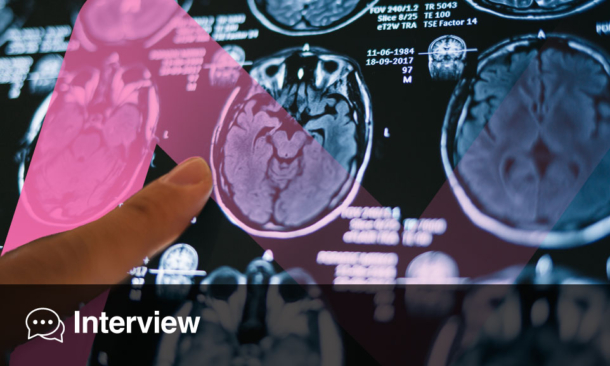Author: Bertie Pearcey, EMJ, London, UK
Citation: EMJ. 2025;10[3]:10-15. https://doi.org/10.33590/emj/GXUO3027
![]()
MYASTHENIA GRAVIS PATHOPHYSIOLOGY AND UNMET NEEDS
The session began with an explanation from Claeys on myasthenia gravis (MG), an autoimmune neuromuscular disease characterised by fluctuating muscle weakness, which continues to challenge clinicians, particularly in its refractory forms.
MG primarily involves pathogenic autoantibodies targeting the post-synaptic membrane of neuromuscular junctions (NMJ). The most common causal antibodies are IgG1 and IgG3 subclasses directed against the acetylcholine receptor, which trigger complement activation and subsequent destruction of NMJ components. Less frequently, MG arises from IgG4 antibodies against muscle-specific kinase or IgG1 antibodies against low-density lipoprotein receptor-related protein 4 (LRP4). Claeys also specified that a small subset of patients (around 5%) are seronegative, with an unknown cause.
Despite advances, she stressed that “Even with the current innovative drugs, the ultimate therapeutic goal of complete disease control can only be reached in a subset of MG patients,” and that “new targeted or precision immunotherapies with increased efficacy and safety are needed for complete elimination of the pathogenic antibodies.”
CAR-T Cell Therapy: A New Frontier
One promising avenue is CAR-T cell therapy, which has revolutionised cancer treatment. Unlike in cancer, where CAR-T cells target B cell proliferation broadly, in autoimmune diseases, they are designed to eliminate B cells producing pathogenic autoantibodies. She highlighted a trial of five patients with systemic lupus erythematosus who achieved drug-free remission after CAR-T therapy, experiencing only mild adverse events such as cytokine release syndrome.1
Promising Results in Early-Phase Studies
Claeys presented preliminary results from a Phase Ib/IIa trial investigating autologous mRNA CAR-T therapy targeting B cell maturation antigen (BCMA) in 14 adults with refractory generalised MG.2 The study tested different dosing intervals and primarily assessed safety. Treatment was well tolerated, with only mild (Grade 1) adverse events reported. Partial plasma cell depletion led to reduced total IgG levels, vaccine antibodies, and autoantibodies, with no opportunistic infections, and a notable reduction in MG disease severity.
Additional case reports supported these findings, showing symptomatic improvement and antibody reduction following anti-CD19,3 anti-BCMA,4 or bispecific CAR-T therapy.5 In one instance, a patient achieved drug-free remission with undetectable acetylcholine receptor antibodies.4 Similar successes have been noted in other B cell-driven autoimmune diseases, including stiff person syndrome and chronic inflammatory demyelinating polyneuropathy. While the results are encouraging, Claeys cautioned that long-term data remain limited, and larger, controlled studies are needed.
GENE THERAPY IN NEUROMUSCULAR DISORDERS: CURRENT CHALLENGES AND THE PROMISE OF ANTISENSE OLIGONUCLEOTIDES
Schoser took the stage to explore the landscape of gene therapies in neuromuscular diseases, highlighting both the promise and remaining challenges.
Gene therapy for neuromuscular disorders currently spans three broad strategies: gene replacement, gene editing, and antisense oligonucleotides (ASO). While gene replacement has shown success in spinal muscular atrophy (SMA), especially in paediatric patients, gene editing technologies such as CRISPR-Cas9 remain largely experimental. ASOs, meanwhile, have entered the clinic with agents for SMA and with emerging candidates for disorders such as myotonic dystrophy.
Schoser distinguished between two key delivery modalities: viral vectors, notably adeno-associated virus (AAV) vectors, and ASOs. He explained that AAV vectors offer durable gene expression but come with immune-related risks, challenges crossing the blood–brain barrier, and limitations with gene size and pre-existing muscle pathology. In contrast, ASOs provide efficient delivery to muscle and brain tissues with fewer immune concerns, but require repeated dosing every 4–8 weeks; a burden for patients and healthcare systems alike. Moreover, ASOs carry potential off-target effects and toxicity that necessitate careful monitoring.
Myotonic Dystrophy: A Paradigm for Antisense Oligonucleotide Therapeutics
Schoser presented myotonic dystrophy Type 1 as a complex multi-system disorder. The disease stems from CTG repeat expansions in the DNA, leading to toxic RNA hairpin structures that trap muscleblind-like proteins and disrupt normal RNA splicing, locking cells in an embryonic state and causing myotonia.
Three types of ASOs targeting myotonic dystrophy Type 1 RNA have shown promise: siRNA-based ASOs, RNase H ASOs, and steric blocking ASOs, each with individual pros and cons.
Looking Forward: Challenges and Innovations
Beyond ASOs, emerging approaches include AAV-delivered siRNAs, small molecules, and preclinical CRISPR-based therapies. Yet, challenges with toxicity, immune responses, and long-term efficacy require ongoing investigation. Notably, ASO treatment cessation may allow toxic RNA repeats to re-expand, highlighting the need for durable solutions.
Schoser concluded by emphasising the importance of drug stability, uptake, and global affordability, notably balancing infusion centre demands against the potential for home administration, to ensure no patients are missed.
EXPLORING NEW HORIZONS IN GENE THERAPY FOR NEURODEGENERATIVE DISORDERS
Francesca Fumagalli, San Raffaele Telethon Institute for Gene Therapy, Milan, Italy, opened her presentation by framing gene therapy as an approach that harnesses viral vectors to deliver genetic material. She summarised four key strategies: replacing faulty genes, silencing harmful gene expression, adding new genes to compensate for dysfunction, and editing genes to correct mutations at their source.
Choosing the Right Vector
Central to successful gene therapy is selecting the most suitable viral vector. Fumagalli highlighted the strengths and limitations of four common types: adenoviral, AAV, murine retroviral, and lentiviral vectors. Each differs in capacity, duration of gene expression, target cells, and safety. For instance, adenoviral vectors can carry larger genes but often elicit immune responses. Conversely, AAV vectors are prized for their long-lasting effects and low immunogenicity, though they accommodate smaller genes.
Delivering Gene Therapy In Vivo: Hope for Rare Disorders
Gene therapy can be administered directly into the patient’s body, in vivo delivery, either systemically or targeted to specific tissues. Fumagalli discussed one example of onasemnogene abeparvovec, an AAV9-based treatment for SMA. By restoring the function of the SMN1 gene, this therapy can improve survival and motor outcomes, especially when given early.6,7 However, it does not cure the disease.
In Duchenne muscular dystrophy, delandistrogene moxeparvovec uses muscle-targeted AAV vectors to express a shortened dystrophin protein. While it increased microdystrophin expression, the primary motor function outcome was not met in trials,8 highlighting challenges in translating biomarker gains into clinical improvements. Approval was granted on the basis of surrogate endpoints, with further data awaited.
Another compelling case Fumagalli explained is eladocagene exuparvovec for aromatic L-amino acid decarboxylase deficiency, a rare condition disrupting dopamine synthesis. Delivered directly to the brain, this gene therapy has led to sustained gains in motor function with a favourable safety profile, particularly when started early.9
The Promise and Complexity of Ex Vivo Stem Cell Therapies
She went on to explain how ex vivo gene therapy presents a more complex approach. For metachromatic leukodystrophy, a demyelinating lysosomal storage disorder caused by arylsulfatase A deficiency and subsequent accumulation of sulfatides in the central and peripheral nervous systems, gene therapy has achieved durable enzyme overexpression, improved neurological outcomes, and slowed disease progression.10 Early intervention before symptom onset is critical to preserve nerve function and quality of life.
Advances in Treating Adrenoleukodystrophy with Gene Therapy
Adrenoleukodystrophy, an X-linked disorder caused by ATP-binding cassette subfamily D member 1 (ABCD1) mutations, leads to the accumulation of toxic very long-chain fatty acids and progressive neurological decline. Traditionally, cerebral adrenoleukodystrophy is treated with allogeneic stem cell transplantation after symptom onset, with significant transplant risks.
Fumagalli’s final point emphasised the risks of these therapies, noting concerns over cases of treatment-related blood cancers with certain ex vivo gene therapies, highlighting the need for vigilance and ongoing research.
Looking Ahead: Early Diagnosis and Lifelong Management
Fumagalli concluded by stressing that successful gene therapy hinges on understanding the genetic and clinical landscape of each disease, guiding vector choice and timing, and that presymptomatic diagnosis through newborn screening can maximise benefits.
To fully realise gene therapy’s potential, she called for investment in natural history studies, long-term patient follow-up, and real-world data. As these technologies mature, they hold the promise of transforming care for many rare neurodegenerative diseases.
ENZYME REPLACEMENT THERAPY IN NEUROMUSCULAR DISORDERS: PROGRESS AND CHALLENGES
Nadine van der Beek, Erasmus University, Rotterdam, the Netherlands, offered a comprehensive overview of enzyme replacement therapies (ERT) and their evolving role in treating lysosomal storage disorders, focusing on Pompe disease. Lysosomal storage disorders are rare inherited metabolic conditions caused by enzyme deficiencies, leading to harmful accumulation of substrates within lysosomes. These disorders typically affect multiple organ systems, complicating their management.
ERT works by administering recombinant human enzymes, usually through intravenous infusions. Once in the bloodstream, these enzymes are taken up by target cells via receptor-mediated endocytosis, transporting the enzyme into lysosomes to degrade accumulated material.
van der Beek continued with a specific introduction to Pompe disease, caused by a deficiency of the lysosomal enzyme acid alpha-glucosidase, which manifests in two main forms. Classic infantile Pompe disease presents within the first year of life with severe muscle weakness and respiratory failure, often fatal if untreated. The late-onset form, emerging in childhood or adulthood, predominantly affects skeletal and respiratory muscles and shows a more variable progression.
She went on to describe how the first generation of ERT for Pompe disease marked a milestone, with the initial human trial starting in 1999 and approval following in 2006. For the first time, treatment extended survival beyond infancy and enabled patients to achieve motor milestones such as independent walking. Subsequent studies demonstrated improvements in lung function and mobility compared to placebo,11 representing a major step forward for affected families.
Refining Treatment and Recognising New Challenges
Over time, experience with ERT has highlighted the critical importance of dosing. While the original approved regimen was 20 mg/kg every other week, many clinicians have adopted higher doses, sometimes up to eight times the original amount, to improve outcomes. This adjustment has led to better survival rates.12
However, long-term follow-up has revealed challenges. van der Beek explained that some patients experience a decline in motor function despite treatment, including previously unrecognised distal muscle weakness. Another significant limitation is that ERT does not cross the blood–brain barrier, leaving central nervous system involvement unaddressed. This has led to new phenotypes characterised by cognitive decline and white matter changes, conditions that only became apparent as treated patients began to live longer.
Moreover, the immune response to infused enzymes remains a concern. Antibody formation can interfere with both enzyme activity and uptake into the tissues, especially in classic infantile patients. Strategies combining immune modulation with ERT have shown promise in mitigating this effect.
Next-Generation Therapies and the Road Ahead
Recent advances have introduced next-generation ERTs designed to improve enzyme delivery and stability.
The COMET trial13 demonstrated that avalglucosidase alfa led to better outcomes in lung function and walking distance compared to the original therapy, with longer-term extension studies confirming these sustained benefits. Similarly, the PROPEL study14 investigating cipaglucosidase alfa with a small molecule chaperone showed promising improvements, though it narrowly missed statistical superiority in some measures.
Looking Forward: Towards Personalised Medicine
van der Beek stressed that despite progress, current ERTs fail to address neurological involvement, and long-term real-world data comparing new treatments are still awaited. Large-scale international registries and longitudinal studies will be crucial to understanding which patients benefit most from each therapy and guiding personalised treatment choices. “We should move away from a one-size-fits-all approach to an individualised, tailored treatment approach,” she concluded.
CONCLUSION
Together, these advances in neuromuscular disease illustrate a transformative era in medicine. While significant challenges remain, the overarching theme is clear: personalised, mechanism-based approaches are the future. With ongoing research, real-world data collection, and innovative trial designs, the future holds promise for more durable, targeted, and patient-centred therapies that could alter the trajectory of neuromuscular diseases and improve quality of life for many.







